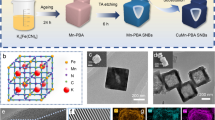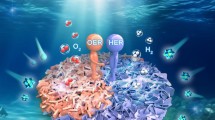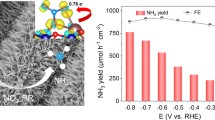Abstract
Recently, cobaltites derived from the Zeolitic Imidazolate Framework 67 (ZIF-67) have stood out as promising electrocatalysts for the oxygen evolution reaction (OER). However, it is still necessary to understand the experimental parameters in the synthesis of these materials and their impacts on electrocatalysis. Thus, this work reports the influence of the solvent on the impregnation of nickel ions into ZIF-67 for the obtention of nickel cobaltites and its impact on the electrocatalytic behavior. The impregnation process was conducted in methanol or ethanol and investigated via infrared spectroscopy, powder X-ray diffraction (XRD) and thermogravimetry, to understand the different mechanisms of interaction between nickel ions and ZIF- 67. Electrocatalysts were obtained after calcination of the precursors at 350 °C in air. Both solvents lead to the formation of nanocomposites. However, the experiments in methanol resulted in the formation of the nanocomposite NiCo2O4/C, while the use of ethanol led to an additional crystalline phase of nickel oxide (NiCo2O4/NiO/C). Measured overpotentials in the alkaline medium were 333 and 341 mV (in KOH 1 M, at j = 10 mA cm−2), respectively, for NiCo2O4/NiO/C and NiCo2O4/C. The material’s high electrocatalytic performance is related to the high concentration of electroactive sites like Ni3+ and Co3+ ions and the presence of oxygen vacancies. Higher catalytic performance for the NiCo2O4/C nanocomposite was observed at high current densities, related to the low electrode resistance.
Graphical Abstract











Similar content being viewed by others
References
Armaroli N, Balzani V (2011) The hydrogen issue. Chemsuschem 4:21–36. https://doi.org/10.1002/cssc.201000182
El-Emam RS, Özcan H (2019) Comprehensive review on the techno-economics of sustainable large-scale clean hydrogen production. J Clean Prod 220:593–609. https://doi.org/10.1016/j.jclepro.2019.01.309
Zhao Q, Yan Z, Chen C, Chen J (2017) Spinels: controlled preparation, oxygen reduction/evolution reaction application, and beyond. Chem Rev 117:10121–10211. https://doi.org/10.1021/acs.chemrev.7b00051
Wang W, Xu M, Xu X et al (2020) Perovskite oxide based electrodes for high-performance photoelectrochemical water splitting. Angew Chemie Int Ed 59:136–152. https://doi.org/10.1002/anie.201900292
Lv L, Yang Z, Chen K et al (2019) 2D layered double hydroxides for oxygen evolution reaction: from fundamental design to application. Adv Energy Mater 9:1–29. https://doi.org/10.1002/aenm.201803358
Zhu K, Zhu X, Yang W (2019) Application of In Situ techniques for the characterization of NiFe-based oxygen evolution reaction (OER) electrocatalysts. Angew Chemie - Int Ed 58:1252–1265. https://doi.org/10.1002/anie.201802923
Favaro M, Yang J, Nappini S et al (2017) Understanding the oxygen evolution reaction mechanism on CoOx using operando ambient-pressure X-ray photoelectron spectroscopy. J Am Chem Soc 139:8960–8970. https://doi.org/10.1021/jacs.7b03211
Jiao Y, Zheng Y, Jaroniec M, Qiao SZ (2015) Design of electrocatalysts for oxygen- and hydrogen-involving energy conversion reactions. Chem Soc Rev 44:2060–2086. https://doi.org/10.1039/c4cs00470a
Li YF (2019) First-principles simulations for morphology and structural evolutions of catalysts in oxygen evolution reaction. Chemsuschem 12:1846–1857. https://doi.org/10.1002/cssc.201802525
Man IC, Su H, Calle-vallejo F et al (2011) Universality in oxygen evolution electrocatalysis on oxide surfaces. ChemCatChem. https://doi.org/10.1002/cctc.201000397
Zhang W, Cui L, Liu J (2020) Recent advances in cobalt-based electrocatalysts for hydrogen and oxygen evolution reactions. J Alloys Compd 821:153542. https://doi.org/10.1016/j.jallcom.2019.153542
Chen Y, Rui K, Zhu J et al (2019) Recent progress on nickel-based oxide/(Oxy)hydroxide electrocatalysts for the oxygen evolution reaction. Chem - A Eur J 25:703–713. https://doi.org/10.1002/chem.201802068
Bo X, Dastafkan K, Zhao C (2019) Design of multi-metallic-based electrocatalysts for enhanced water oxidation. ChemPhysChem 20:2936–2945. https://doi.org/10.1002/cphc.201900507
Hua Y, Li X, Chen C, Pang H (2019) Cobalt based metal-organic frameworks and their derivatives for electrochemical energy conversion and storage. Chem Eng J 370:37–59. https://doi.org/10.1016/j.cej.2019.03.163
Liang Q, Chen J, Wang F, Li Y (2020) Transition metal-based metal-organic frameworks for oxygen evolution reaction. Coord Chem Rev 424:213488. https://doi.org/10.1016/j.ccr.2020.213488
Wang W, Li Y, Zhang R et al (2011) Metal-organic framework as a host for synthesis of nanoscale Co 3O4 as an active catalyst for CO oxidation. Catal Commun 12:875–879. https://doi.org/10.1016/j.catcom.2011.02.001
Zhong Y, Xu X, Wang W, Shao Z (2019) Recent advances in metal-organic framework derivatives as oxygen catalysts for zinc-air batteries. Batter Supercaps 2:272–289. https://doi.org/10.1002/batt.201800093
Lourenço AA, Silva VD, da Silva RB et al (2021) Metal-organic frameworks as template for synthesis of Mn3+/Mn4+ mixed valence manganese cobaltites electrocatalysts for oxygen evolution reaction. J Colloid Interface Sci 582:124–136. https://doi.org/10.1016/j.jcis.2020.08.041
Yu D, Wu B, Ge L et al (2016) Decorating nanoporous ZIF-67-derived NiCo2O4 shells on a Co3O4 nanowire array core for battery-type electrodes with enhanced energy storage performance. J Mater Chem A 4:10878–10884. https://doi.org/10.1039/c6ta04286d
Zhou S, Hao C, Wang J et al (2018) Metal-organic framework templated synthesis of porous NiCo2O4/ZnCo2O4/Co3O4 hollow polyhedral nanocages and their enhanced pseudocapacitive properties. Chem Eng J 351:74–84. https://doi.org/10.1016/j.cej.2018.06.070
Menezes PW, Indra A, Gutkin V, Driess M (2017) Boosting electrochemical water oxidation through replacement of Oh Co sites in cobalt oxide spinel with manganese. Chem Commun 53:8018–8021. https://doi.org/10.1039/c7cc03749j
Li H, Chen L, Jin P et al (2020) Synthesis of Co2-: XNixO2 (0 < x < 1.0) hexagonal nanostructures as efficient bifunctional electrocatalysts for overall water splitting. Dalt Trans 49:6587–6595. https://doi.org/10.1039/d0dt00925c
Lai C, Liu X, Wang Y et al (2020) Bimetallic organic framework-derived rich pyridinic N-doped carbon nanotubes as oxygen catalysts for rechargeable Zn-air batteries. J Power Sour. https://doi.org/10.1016/j.jpowsour.2020.228470
Huang C, Su X, Gu X et al (2020) Bimetallic oxide nanoparticles confined in ZIF-67-derived carbon for highly selective oxidation of saturated C–H bond in alkyl arenes. Appl Organomet Chem. https://doi.org/10.1002/aoc.6047
Chen L, Wang H, Shen X et al (2019) A novel route for the generation of Co/CoZn/CoNi layered double hydroxides at ambient temperature. Inorg Chem Front. https://doi.org/10.1039/c9qi00340a
Zhong G, Liu D, Zhang J (2018) The application of ZIF-67 and its derivatives: adsorption, separation, electrochemistry and catalysts. J Mater Chem A 6:1887–1899. https://doi.org/10.1039/c7ta08268a
Zhao S, Chen J (2019) Metal organic framework-derived Ni/Zn/Co/NC composites as efficient catalyst for oxygen evolution reaction. J Porous Mater 26:381–387. https://doi.org/10.1007/s10934-018-0612-5
Li L, Yang Q, Zhang C et al (2019) Hollow-structural Ag/Co3O4 nanocatalyst for CO oxidation: interfacial synergistic effect. ACS Appl Nano Mater 2:3480–3489. https://doi.org/10.1021/acsanm.9b00466
Hu H, Guan B, Xia B, Lou XW (2015) Designed formation of Co3O4/NiCo2O4 double-shelled nanocages with enhanced pseudocapacitive and electrocatalytic properties. J Am Chem Soc 137:5590–5595. https://doi.org/10.1021/jacs.5b02465
Kwon HT, Jeong HK, Lee AS et al (2015) Heteroepitaxially grown zeolitic imidazolate framework membranes with unprecedented propylene/propane separation performances. J Am Chem Soc 137:12304–12311. https://doi.org/10.1021/jacs.5b06730
Ferraro JR (1962) Interpretation of the Infrared Spectra of Inorganic Molecules. In: Progress in Infrared Spectroscopy
Faik Demirörs A, Eser BE, Dag Ö (2005) Liquid crystalline mesophases of pluronics (L64, P65, and P123) and transition metal nitrate salts ([M(H2O)6](NO3)2). Langmuir. https://doi.org/10.1021/la047136l
Dag O, Samarskaya O, Tura C et al (2003) Spectroscopic investigation of nitrate-metal and metal-surfactant interactions in the solid AgNO3/C12EO10 and liquid-crystalline [M(H2O)n](NO3)2/C12EO10 systems. Society. 19:3671–3676
Jiang Z, Li Z, Qin Z et al (2013) LDH nanocages synthesized with MOF templates and their high performance as supercapacitors. Nanoscale 5:11770–11775. https://doi.org/10.1039/c3nr03829g
Li R, Hu Z, Shao X et al (2016) Large scale synthesis of NiCo layered double hydroxides for superior asymmetric electrochemical capacitor. Sci Rep 6:1–9. https://doi.org/10.1038/srep18737
Li L, Feng Y, Qiu Y et al (2020) A three-dimensional bimetallic oxide NiCo2O4 derived from ZIF-67 with a cage-like morphology as an electrochemical platform for Hg2+ detection. Microchem J. https://doi.org/10.1016/j.microc.2020.104762
Chen J, Ru Q, Mo Y et al (2016) Design and synthesis of hollow NiCo2O4 nanoboxes as anodes for lithium-ion and sodium-ion batteries. Phys Chem Chem Phys 18:18949–18957. https://doi.org/10.1039/c6cp02871c
Park SK, Yang SH, Kang YC (2018) Rational design of metal-organic framework-templated hollow NiCo2O4 polyhedrons decorated on macroporous CNT microspheres for improved lithium-ion storage properties. Chem Eng J 349:214–222. https://doi.org/10.1016/j.cej.2018.05.091
Birks LS, Friedman H (1946) Particle size determination from x-ray line broadening. J Appl Phys doi 10(1063/1):1707771
Zhu Y, Chen J, Zhao N et al (2015) Large-scale synthesis of uniform NiCo2O4 nanoparticles with supercapacitive properties. Mater Lett. https://doi.org/10.1016/j.matlet.2015.07.110
Li Y, Wu X, Wang S et al (2017) Surfactant-assisted solvothermal synthesis of NiCo2O4 as an anode for lithium-ion batteries. RSC Adv. https://doi.org/10.1039/c7ra06172b
da Silva RB, Pinto RA, Soares JM et al (2019) Effect of the synthesis method and calcination temperature on the formation of Ni–NiO nanocomposites. J Sol-Gel Sci Technol. https://doi.org/10.1007/s10971-019-05038-8
Antony RP, Satpati AK, Bhattacharyya K, Jagatap BN (2016) MOF derived nonstoichiometric NixCo3−xO4−ynanocage for superior electrocatalytic oxygen evolution. Adv Mater Interfaces 3:1–12. https://doi.org/10.1002/admi.201600632
Sun C, Yang J, Rui X et al (2015) MOF-directed templating synthesis of a porous multicomponent dodecahedron with hollow interiors for enhanced lithium-ion battery anodes. J Mater Chem A 3:8483–8488. https://doi.org/10.1039/c5ta00455a
Hu H, Liu J, Xu Z et al (2019) Hierarchical porous Ni/Co-LDH hollow dodecahedron with excellent adsorption property for Congo red and Cr(VI) ions. Appl Surf Sci 478:981–990. https://doi.org/10.1016/j.apsusc.2019.02.008
Yang K, Yan Y, Chen W et al (2019) Yolk-shell bimetallic metal-organic frameworks derived multilayer core-shells NiCo2O4/NiO structure spheres for high-performance supercapacitor. J Electroanal Chem 851:113445. https://doi.org/10.1016/j.jelechem.2019.113445
Wang Y, Wang Y, Lu L et al (2020) Hierarchically hollow and porous NiO/NiCo2O4nanoprisms encapsulated in graphene oxide for lithium storage. Langmuir 36:9668–9674. https://doi.org/10.1021/acs.langmuir.0c00801
Atchuta SR, Sakthivel S, Barshilia HC (2019) Nickel doped cobaltite spinel as a solar selective absorber coating for efficient photothermal conversion with a low thermal radiative loss at high operating temperatures. Sol Energy Mater Sol Cells. https://doi.org/10.1016/j.solmat.2019.109917
Chen K, Bai S, Li H et al (2020) The Co3O4 catalyst derived from ZIF-67 and their catalytic performance of toluene. Appl Catal A Gen 599:117614. https://doi.org/10.1016/j.apcata.2020.117614
Lin D, Duan P, Yang W et al (2020) Facile controlled synthesis of core-shell/yolk-shell/hollow ZIF-67@Co-LDH/SiO2: via a self-template method. Inorg Chem Front 7:1643–1650. https://doi.org/10.1039/c9qi01684h
Verma S, Joshi HM, Jagadale T et al (2008) Nearly monodispersed multifunctional NiCo2O4 spinel nanoparticles: magnetism, infrared transparency, and radiofrequency absorption. J Phys Chem C. https://doi.org/10.1021/jp804923t
Zhu CM, Wang LG, Liu FC, Kong WJ (2019) Exchange bias behaviors up to room temperature in NiCo 2 O 4 /NiO nanoparticle system. Ceram Int 45:9878–9883. https://doi.org/10.1016/j.ceramint.2019.02.028
Li L, Tian T, Jiang J, Ai L (2015) Hierarchically porous Co3O4 architectures with honeycomb-like structures for efficient oxygen generation from electrochemical water splitting. J Power Sources 294:103–111. https://doi.org/10.1016/j.jpowsour.2015.06.056
Meena PL, Kumar R, Sreenivas K (2018) Structural, elastic and magnetic properties of spinel Co3O4. Indian J Pure Appl Phys
Windisch CF, Exarhos GJ, Owings RR (2004) Vibrational spectroscopic study of the site occupancy distribution of cations in nickel cobalt oxides. J Appl Phys 95:5435–5442. https://doi.org/10.1063/1.1699505
McClure DS (1957) The distribution of transition metal cations in spinels. J Phys Chem Solids 3:311–317. https://doi.org/10.1016/0022-3697(57)90034-3
Nayak S, Dasari K, Joshi DC, et al (2011) Spectroscopic studies of Co 3 O 4 and. 2: 1–12
Sun S, Jin X, Cong B et al (2019) Construction of porous nanoscale NiO/NiCo2O4 heterostructure for highly enhanced electrocatalytic oxygen evolution activity. J Catal 379:1–9. https://doi.org/10.1016/j.jcat.2019.09.010
Ramos Ramón JA, Ortiz-Quiñonez JL, Ray A et al (2020) Inducing superparamagnetism and high magnetization in nickel cobaltite (NixCo3- xO4) spinel nanoparticles by controlling Ni mole fraction and cation distribution. J Phys Chem C 124:18264–18274. https://doi.org/10.1021/acs.jpcc.0c03075
Dubey P, Kaurav N, Devan RS et al (2018) The effect of stoichiometry on the structural, thermal and electronic properties of thermally decomposed nickel oxide. RSC Adv 8:5882–5890. https://doi.org/10.1039/C8RA00157J
Grosvenor AP, Biesinger MC, Smart RSC, McIntyre NS (2006) New interpretations of XPS spectra of nickel metal and oxides. Surf Sci 600:1771–1779. https://doi.org/10.1016/j.susc.2006.01.041
Cui M, Ding X, Huang X et al (2019) Ni3+-induced hole states enhance the oxygen evolution reaction activity of NixCo3-xO4 electrocatalysts. Chem Mater 31:7618–7625. https://doi.org/10.1021/acs.chemmater.9b02453
Franco A, Zapf V (2008) Temperature dependence of magnetic anisotropy in nanoparticles of CoxFe(3–x)O4. J Magn Magn Mater. https://doi.org/10.1016/j.jmmm.2007.08.009
Bozorth RM (1993) Ferromagnetism
Kumar BS, Dhanasekhar C, Venimadhav A et al (2018) Pyrolysis-controlled synthesis and magnetic properties of sol–gel electrospun nickel cobaltite nanostructures. J Sol-Gel Sci Technol. https://doi.org/10.1007/s10971-018-4672-4
Silambarasan M, Ramesh PS, Geetha D (2017) Facile one-step synthesis, structural, optical and electrochemical properties of NiCo2O4 nanostructures. J Mater Sci Mater Electron. https://doi.org/10.1007/s10854-016-5527-9
Sattar AA, El-Sayed HM, Alsuqia I (2015) Structural and magnetic properties of CoFe2O4/NiFe2O4 core/shell nanocomposite prepared by the hydrothermal method. J Magn Magn Mater. https://doi.org/10.1016/j.jmmm.2015.07.039
Pottker WE, Ono R, Cobos MA et al (2018) Influence of order-disorder effects on the magnetic and optical properties of NiFe2O4 nanoparticles. Ceram Int. https://doi.org/10.1016/j.ceramint.2018.06.190
Liu ZQ, Xiao K, Xu QZ et al (2013) Fabrication of hierarchical flower-like super-structures consisting of porous NiCo2O4 nanosheets and their electrochemical and magnetic properties. RSC Adv. https://doi.org/10.1039/c3ra23084h
Rodríguez Torres CE, Pasquevich GA, Zélis PM et al (2014) Oxygen-vacancy-induced local ferromagnetism as a driving mechanism in enhancing the magnetic response of ferrites. Phys Rev B - Condens Matter Mater Phys. https://doi.org/10.1103/PhysRevB.89.104411
Choudhury B, Choudhury A, Maidul Islam AKM et al (2011) Effect of oxygen vacancy and dopant concentration on the magnetic properties of high spin Co2 doped TiO2 nanoparticles. J Magn Magn Mater. https://doi.org/10.1016/j.jmmm.2010.09.043
Silva RM, Raimundo RA, Fernandes WV et al (2018) Proteic sol-gel synthesis, structure and magnetic properties of Ni/NiO core-shell powders. Ceram Int. https://doi.org/10.1016/j.ceramint.2017.12.248
Kodama RH, Makhlouf SA, Berkowitz AE (1997) Finite size effects in antiferromagnetic nio nanoparticles. Phys Rev Lett. https://doi.org/10.1103/PhysRevLett.79.1393
Kiwi M (2001) Exchange bias theory. J. Magn. Magn. Mater.
Pinheiro AVB, da Silva RB, Morales MA et al (2020) Exchange bias and superspin glass behavior in nanostructured CoFe2O4-Ag composites. J Magn Magn Mater. https://doi.org/10.1016/j.jmmm.2019.165940
Rodrigues APG, Morales MA, Silva RB et al (2020) Positive exchange bias effect in LaCr05Fe05O3 perovskite. J Phys Chem Solids. 141:109334. https://doi.org/10.1016/j.jpcs.2020.109334
Wang G, Chen Z, He H et al (2018) Room temperature exchange bias in structure-modulated single-phase multiferroic materials. Chem Mater. https://doi.org/10.1021/acs.chemmater.8b02798
Wang HY, Hsu YY, Chen R et al (2015) Ni3+-induced formation of active NiOOH on the spinel Ni-Co oxide surface for efficient oxygen evolution reaction. Adv Energy Mater 5:1–8. https://doi.org/10.1002/aenm.201500091
Miao X, Wu L, Lin Y et al (2019) The role of oxygen vacancies in water oxidation for perovskite cobalt oxide electrocatalysts: are more better? Chem Commun 55:1442–1445. https://doi.org/10.1039/c8cc08817a
Shinagawa T, Garcia-Esparza AT, Takanabe K (2015) Insight on Tafel slopes from a microkinetic analysis of aqueous electrocatalysis for energy conversion. Sci Rep 5:1–21. https://doi.org/10.1038/srep13801
Li G, Anderson L, Chen Y et al (2018) New insights into evaluating catalyst activity and stability for oxygen evolution reactions in alkaline media. Sustain Energy Fuels. https://doi.org/10.1039/c7se00337d
Zhou J, Zheng H, Luan Q et al (2019) Improving the oxygen evolution activity of Co3O4 by introducing Ce species derived from Ce-substituted ZIF-67. Sustain Energy Fuels 3:3201–3207. https://doi.org/10.1039/c9se00541b
McCrory CCL, Jung S, Peters JC, Jaramillo TF (2013) Benchmarking heterogeneous electrocatalysts for the oxygen evolution reaction. J Am Chem Soc 135:16977–16987. https://doi.org/10.1021/ja407115p
Angulo A, van der Linde P, Gardeniers H et al (2020) Influence of bubbles on the energy conversion efficiency of electrochemical reactors. Joule 4:555–579. https://doi.org/10.1016/j.joule.2020.01.005
Ahn SH, Choi I, Park HY et al (2013) Effect of morphology of electrodeposited Ni catalysts on the behavior of bubbles generated during the oxygen evolution reaction in alkaline water electrolysis. Chem Commun 49:9323–9325. https://doi.org/10.1039/c3cc44891f
Harrington DA, Conway BE (1987) ac Impedance of faradaic reactions involving electrosorbed intermediates-I. Kinetic Theor Electrochim Acta 32:1703–1712. https://doi.org/10.1016/0013-4686(87)80005-1
Doyle RL, Lyons MEG (2013) Kinetics and mechanistic aspects of the oxygen evolution reaction at hydrous iron oxide films in base. J Electrochem Soc 160:H142–H154. https://doi.org/10.1149/2.015303jes
Swierk JR, Klaus S, Trotochaud L et al (2015) Electrochemical study of the energetics of the oxygen evolution reaction at nickel iron (Oxy)hydroxide catalysts. J Phys Chem C 119:19022–19029. https://doi.org/10.1021/acs.jpcc.5b05861
Raimundo RA, Silva VD, Medeiros ES et al (2020) Multifunctional solution blow spun NiFe–NiFe2O4 composite nanofibers: structure, magnetic properties and OER activity. J Phys Chem Solids. https://doi.org/10.1016/j.jpcs.2019.109325
Lyons MEG, Brandon MP (2009) The significance of electrochemical impedance spectra recorded during active oxygen evolution for oxide covered Ni, Co and Fe electrodes in alkaline solution. J Electroanal Chem 631:62–70. https://doi.org/10.1016/j.jelechem.2009.03.019
Wu Y, Gao Y, He H, Zhang P (2019) Electrodeposition of self-supported Ni–Fe–Sn film on Ni foam: an efficient electrocatalyst for oxygen evolution reaction. Electrochim Acta 301:39–46. https://doi.org/10.1016/j.electacta.2019.01.151
Acknowledgements
The authors gratefully acknowledge CAPES for its financial support. Annaíres A. Lourenço and Vinícius D. Silva thanks CAPES for their Master and PhD scholarship, respectively. Daniel A. Macedo acknowledges CNPq (Brazil, 431428/2018-2 and 309430/2019-4). The authors also wish to thank Prof. Dr. Rubens M. Nascimento (UFRN) for support with FESEM. Francisco Loureiro and Duncan Fagg wish to thank the FCT (Fundação para a Ciência e a Tecnologia), grants numbers CEECIND/02797/2020, PTDC/CTM-CTM/2156/2020, PTDC/QUI-ELT/3681/2020, POCI-01-0247-FEDER-039926, POCI-01-0145-FEDER-032241, UIDB/00481/2020 and UIDP/00481/2020; and also, by Centro Portugal Regional Operational Programme (Centro2020), under the PORTUGAL 2020 Partnership Agreement, through the European Regional Development Fund (ERDF), grant number CEN-TRO-01-0145-FEDER-022083.
Author information
Authors and Affiliations
Corresponding authors
Ethics declarations
Conflict of interest
All authors declare no conflict of interest.
Additional information
Handling Editor: Mark Bissett.
Publisher's Note
Springer Nature remains neutral with regard to jurisdictional claims in published maps and institutional affiliations.
Supplementary Information
Below is the link to the electronic supplementary material.
Rights and permissions
About this article
Cite this article
Lourenço, A.A., Silva, V.D., Silva, R.B. et al. Tuning chemical and surface composition of nickel cobaltite-based nanocomposites through solvent and its impact on electrocatalytic activity for oxygen evolution. J Mater Sci 57, 5097–5117 (2022). https://doi.org/10.1007/s10853-022-06941-2
Received:
Accepted:
Published:
Issue Date:
DOI: https://doi.org/10.1007/s10853-022-06941-2




